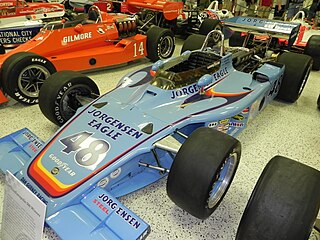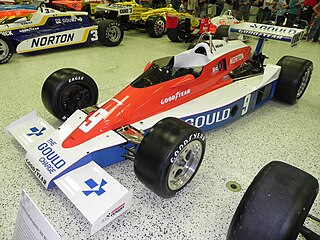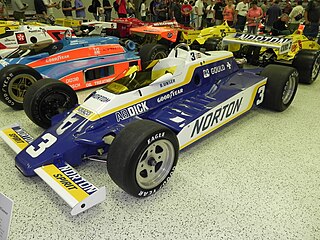
The 49th International 500-Mile Sweepstakes was held at the Indianapolis Motor Speedway in Speedway, Indiana on Monday, May 31, 1965.

The 54th 500 Mile International Sweepstakes was held at the Indianapolis Motor Speedway in Speedway, Indiana on Saturday, May 30, 1970.

The 55th 500 Mile International Sweepstakes was a motor race held at the Indianapolis Motor Speedway in Speedway, Indiana on Saturday, May 29, 1971. Al Unser Sr. won for the second consecutive year, dominating most of the race. Unser became the fourth driver to win the Indy 500 in back-to-back years, and it was his second of a record-tying four Indy victories.

The 57th 500 Mile International Sweepstakes was held at the Indianapolis Motor Speedway in Speedway, Indiana, on Wednesday, May 30, 1973. The race was held over three days because of rain and two major accidents. Three competitors—two drivers and one pit crew member—died from injuries suffered as a result of accidents that occurred during the month, another driver was critically injured, and over a dozen spectators suffered injuries and/or burns. After 133 laps, rain halted the race, and Gordon Johncock was declared the winner, the first of his two Indy triumphs.

The 59th 500 Mile International Sweepstakes was held at the Indianapolis Motor Speedway in Speedway, Indiana on Sunday, May 25, 1975. A. J. Foyt started on the pole position and Bobby Unser won his second Indianapolis 500. Dan Gurney, one of the founders of All American Racers, who finished second as a driver himself in 1968–1969, won his first and only Indy 500 as a car owner. Gurney's Eagle chassis itself scored its third "500" win. The race was part of the 1975 USAC National Championship Trail.

The 62nd 500 Mile International Sweepstakes was held at the Indianapolis Motor Speedway in Speedway, Indiana on Sunday, May 28, 1978. Danny Ongais dominated the early stages of the race but eventually dropped out with a blown engine. Al Unser Sr. dominated the second half, and held a large lead late in the race. However, Unser bent the front wing of his Lola during a pit stop on lap 180, causing his handling to go away over the final twenty laps. Second place Tom Sneva charged to catch Unser's crippled Lola but came up 8 seconds short at the finish line – the second-closest finish in Indy history to that point. Unser held off the challenge, and became a three-time winner of the 500. It was Al Unser's third Indy victory in the decade of the 1970s, and the fifth of nine overall victories by the Unser family.

The 63rd 500 Mile International Sweepstakes was held at the Indianapolis Motor Speedway in Speedway, Indiana, on Sunday May 27, 1979. Second-year driver Rick Mears took the lead for the final time with 18 laps to go, and won his first of four Indianapolis 500 races. It was also Mears' first of a record six Indy 500 pole positions. Brothers Al and Bobby Unser combined to lead 174 of the 200 laps, but Al dropped out around the midpoint, and Bobby slipped to 5th place at the finish nursing mechanical issues. It was also Roger Penske's second Indy 500 victory as a car owner.

The 64th 500 Mile International Sweepstakes was held at the Indianapolis Motor Speedway in Speedway, Indiana on Sunday, May 25, 1980. Johnny Rutherford won the pole position, led 118 laps, and won the race by a commanding 29.92 second margin. After failing to finish the race the year before, Jim Hall's radical new Chaparral 2K ground effects chassis was a heavy favorite entering the month, and drove a flawless race. Rutherford, the winner in 1974 and 1976, became the sixth driver to win the Indy 500 three times.

The 65th Indianapolis 500 was held at the Indianapolis Motor Speedway in Speedway, Indiana, on Sunday, May 24, 1981. The race is widely considered one of the most controversial races in Indy history. Bobby Unser took the checkered flag as the winner, with Mario Andretti finishing second. After the conclusion of the race, USAC officials ruled that Unser had passed cars illegally while exiting the pit area during a caution on lap 149. Unser was subsequently issued a one-position penalty. The next morning, the official race results were posted, and Unser was dropped to second place. Andretti was elevated to first place and declared the race winner.

The 76th Indianapolis 500 was held at the Indianapolis Motor Speedway in Speedway, Indiana, on Sunday, May 24, 1992. The race is famous for the fierce battle in the closing laps, as race winner Al Unser Jr. held off second place Scott Goodyear for the victory by 0.043 seconds, the closest finish in Indy history. Unser Jr. became the first second-generation driver to win the Indy 500, following in the footsteps of his father Al Unser Sr. He also became the third member of the famous Unser family to win the race.

The 75th Indianapolis 500 was held at the Indianapolis Motor Speedway in Speedway, Indiana, on Sunday, May 26, 1991. Rick Mears won from the pole position, becoming the third four-time winner of the Indy 500, joining A. J. Foyt and Al Unser. During time trials, Mears also established an Indy record by winning his sixth career pole position. The month of May for Mears was tumultuous, as he suffered his first ever crash at Indy since arriving as a rookie in 1977. The wreck during a practice run totaled his primary car, and broke a bone in his right foot. Mears kept the injury mostly secret, and later admitted that the pain he experienced during the race was so bad, he had to cross his legs in the car and push the accelerator pedal down with his left foot.

The Pocono 500 was an IndyCar Series race held at Pocono Raceway in Long Pond, Pennsylvania, located in the Pocono Mountains. The first Indy car race at Pocono was held in 1971. It was the first major event held at the track, shortly after its completion. The race was sanctioned by USAC from 1971 to 1981, and then by CART from 1982 to 1989, and was known as the Pocono 500. The race was removed from the CART calendar following the 1989 running, due to poor track conditions, as well as poor revenue for the promoter.

The 1971 Pocono 500, the inaugural running of the event, was held at the Pocono Raceway in Long Pond, Pennsylvania, on Saturday, July 3, 1971. Branded as the 1971 Schaefer 500 for sponsorship reasons, the race is notable as the first IndyCar win for Team Penske and the first for driver Mark Donohue.

The 1972 Pocono 500, the 2nd running of the event, was held at the Pocono Raceway in Long Pond, Pennsylvania, on Saturday, July 29, 1972. Branded as the 1972 Schaefer 500 for sponsorship reasons, the race was won by Joe Leonard. The race is notable for its impact by Hurricane Agnes and the confrontation between the track and USAC.

The 1973 Pocono 500, the 3rd running of the event, was held at the Pocono Raceway in Long Pond, Pennsylvania, on Sunday, July 1, 1973. Branded as the 1973 Schaefer 500 for sponsorship reasons, the race was won by A. J. Foyt who passed Roger McCluskey on the last lap.

The 1974 Pocono 500, the 4th running of the event, was held at the Pocono Raceway in Long Pond, Pennsylvania, on Sunday, June 30, 1974. Branded as the 1974 Schaefer 500 for sponsorship reasons, the race was won by Johnny Rutherford, who one month earlier won the 1974 Indianapolis 500.

The 1970 California 500, the inaugural running of the event, was held at the Ontario Motor Speedway in Ontario, California, on Sunday, September 6, 1970. The event was race number 12 of 18 in the 1970 USAC Championship Car season. The race was won by Jim McElreath, his final Indy Car victory. The race commenced an 11-year history of the California 500 being a part of IndyCar racing's Triple Crown.

The 1972 California 500, the third running of the event, was held at the Ontario Motor Speedway in Ontario, California, on Sunday, September 3, 1972. The event was race number 8 of 10 in the 1972 USAC Championship Car season. The race was won by Roger McCluskey, his first 500-mile Indy Car victory. In qualifying, Jerry Grant became the first IndyCar driver to ever break to 200 mile per hour barrier.

The 1973 California 500, the fourth running of the event, was held at the Ontario Motor Speedway in Ontario, California, on Sunday, September 2, 1973. The event was race number 11 of 16 in the 1973 USAC Championship Car season. The race was won by Wally Dallenbach Sr., his only 500-mile Indy Car victory.

The 1974 California 500, the fifth running of the event, was held at the Ontario Motor Speedway in Ontario, California, on Sunday, March 10, 1974. The event was race number 3 of 14 in the 1974 USAC Championship Car season. The race was won by Bobby Unser, his first California 500 victory.



















